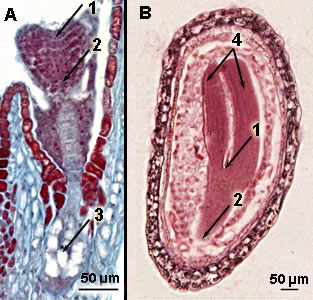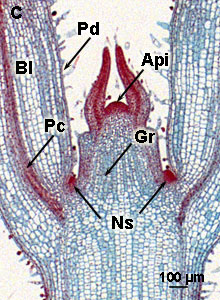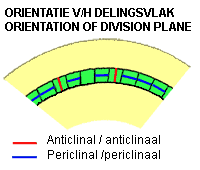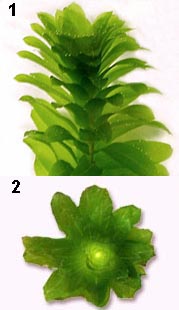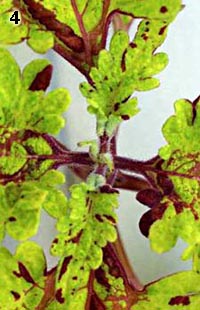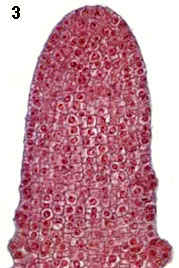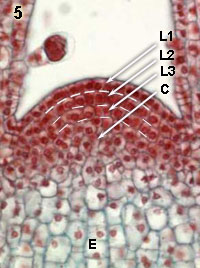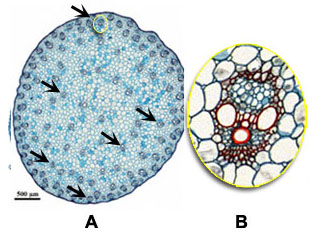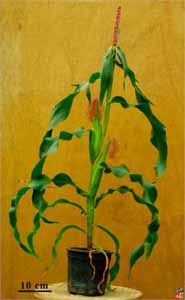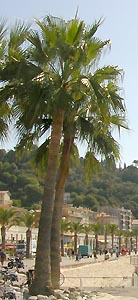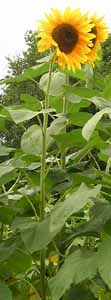Primary growth |
||||||||||||||||||||||||||||||||||||||
Lower plants like ferns and horsetails have as growth points apical cells that have the shape of an inverted pyramid or parabolic dish.
In higher plants growth does not arise from a single cell, but from growth zones, called meristems, in which groups of dividing cells occur. (Meristems consist of undifferentiated cells that have the capacity to divide; meristos means 'divided' in Greek). The first meristems can be found even before seed germination: during the early development of the plant embryo, two apical meristems arise, at the tip of the rootlet and at the tip of the shootlet. These two apical meristems lead to the formation of the primary meristems from which primary tissues arise: root tissue develops from the apical root meristem and leaves and original tissue layers in the stem develop from the apical shoot meristem.
Voorbeelden: topmeristemen in embryo's en groeiende planten
The primary meristems, which arise from the apical shoot meristem, lead to the formation of the following primary tissues in the stem:
New side shoots (Ns) are formed by mitotic divisions in the cortex, just below the epidermis, parallel to the surface (periclinal). In a later stage also perpendicularly-oriented divisions (anticlinal) occur and finally also in the epidermis (exclusively anticlinal).
The apical meristem remains active during the whole development of the plant, in both monocots and dicots; in the primary meristematic zones increase in length through cell division (mitosis) occurs. Besides division, cell stretching and expansion contribute to the increase in size of the plant.
Growth and stem structure in monocots, dicots and in woody Gymnosperms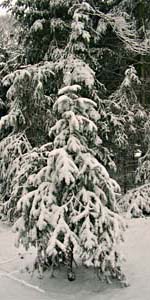 Along with the increase in foliage and branching of a growing stem, the need for new vascular, filling and supportive tissues also raises. In dicots (Example: Coleus and sunflower) but also in woody gymnosperms (here left, see also examples of microscopic slides of the stem of pine) a new division layer (cambium layer) arises which is involved in lateral expansion, so-called secondary growth (more about thickening growth in the stem in the pages on secondary meristems).
Along with the increase in foliage and branching of a growing stem, the need for new vascular, filling and supportive tissues also raises. In dicots (Example: Coleus and sunflower) but also in woody gymnosperms (here left, see also examples of microscopic slides of the stem of pine) a new division layer (cambium layer) arises which is involved in lateral expansion, so-called secondary growth (more about thickening growth in the stem in the pages on secondary meristems).
On the other side in monocots (Examples: Elodea and maize) primary growth is the only way to add new cells to the plant body, namely by divisions in the apical meristem, protoderm, procambium and groundmeristem. Palmbomen, which also belong to the monocots, know a kind of pseudo-thickening growth: however, this mode of lateral expansion of the stem still relies on division of cells derived from the -primary- apical meristem. Among monocotyledonous plants, only a very small group to which Dracaena belongs, shows true secondary growth. Another characteristics of monocots, besides the absence of vascular cambium, is that the vascular bundles are scattered through the ground tissue of the stem (black arrows in overview A on maize), and that each vascular bundle forms a close structure (presence of a sheath, see B). In dicots the vascular bundles are arranged in an open ring in the young stem (orange arrows in overview C in sunflower) and within vascular bundles xylem and phloem are divided by a cambium layer (dashed line in D) from which further growth and differentiation can follow.
|
||||||||||||||||||||||||||||||||||||||
